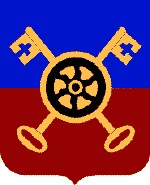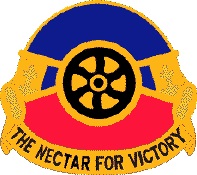260th Quartermaster Battalion, US Army
260TH QUARTERMASTER BATTALION, US ARMY
(Coat of Arms) |
(Distinctive Unit Insignia) |
Official blazon
Shield: Per fess Azure and Gules (brick red), two keys saltirewise wards up and out Or surmounted by a bezant charged with a wheel with six wavy spokes Sable, hub Yellow.
Motto: THE NECTAR FOR VICTORY.
Distinctive Unit Insignia. Description: A gold color metal and enamel device 1 1/8 inches (2.86cm) in width overall, consisting of two gold keys saltirewise with wards up, behind a black wheel with six wavy spokes, above the motto and wheel a blue semi-circle, in base an area of red, all above a gold scroll inscribed "THE NECTAR FOR VICTORY" in black.
Origin/meaning
Coat of Arms: Blue is a color traditionally associated with the Quartermaster Corps. Brick red, representative of the Transportation Corps, alludes to the unit's transportation capability. The crossed keys symbolize Quartermaster units as the keeper of supplies. The black wheel with wavy spokes refers to the continuous supply of bulk petroleum. The two (2) keys, the six (6) spokes of the wheel and circle (0) of the hub, further allude to the numerical designation of the unit.
Distinctive Unit Insignia: Blue is a color traditionally associated with the Quartermaster Corps. Brick red, representative of the Transportation Corps, alludes to the unit's transportation capability. The crossed keys symbolize Quartermaster units as the keeper of supplies. The black wheel with wavy spokes refers to the continuous supply of bulk petroleum. The two (2) keys, the six (6) spokes of the wheel and circle (0) of the hub, further allude to the numerical designation of the unit.
The arms were approved on 26 February 1993. The Distinctive Unit Insignia was originally approved on 6 July 1967. It was amended on 26 February 1993 to include metric measurements in the description and revise the symbolism. Literature: Image from Wikimedia Commons
and The Institute of Heraldry, US Army. Information from The Institute of Heraldry, US Army.

